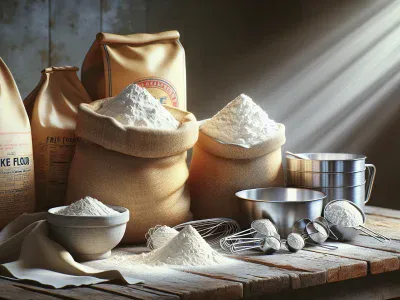Difference Between Rye and Wheat: Taste, Nutrition, and Baking Insights Explained
Picture biting into a slice of freshly baked bread, its earthy aroma filling the air. what makes one loaf hearty and robust while another feels soft and delicate? The secret often lies in the grain—rye or wheat. These two staples may look similar at first glance, but their differences shape everything from flavor to texture.
Whether you’re selecting flour for baking or choosing a healthier option for your diet, understanding rye and wheat can be a game-changer. Rye’s bold, nutty profile contrasts with wheat’s mild sweetness, offering unique experiences for your taste buds. But it’s not just about flavor—these grains also differ in nutrition, versatility, and even how they grow.
Overview Of Rye And Wheat
Rye and wheat are two staple grains with distinct characteristics, influencing their use in food production. Their differences extend to taste, texture, and nutritional content.
What Is Rye?
Rye is a cereal grain known for its bold, earthy flavor. It’s commonly used in bread like pumpernickel or rye loaves, giving them a dense structure. Rye grows well in colder climates and poor soils, making it a resilient crop. Its flour contains less gluten than wheat flour, resulting in denser baked goods.
Nutritionally, rye provides dietary fiber and essential minerals like manganese and phosphorus. For example, 100 grams of rye flour offers around 15 grams of fiber (USDA). This makes it beneficial for digestion when included in your diet.
What Is Wheat?
Wheat is one of the most widely cultivated grains globally due to its versatility and mild sweetness. It’s used in various forms such as all-purpose flour or whole wheat flour for baking bread, pasta, and pastries. Unlike rye, wheat requires moderate climates with fertile soil to thrive.
Containing higher gluten levels than rye, wheat provides elasticity to doughs needed for fluffy bread textures. Whole wheat is rich in nutrients like B vitamins and iron; 100 grams of whole wheat flour delivers approximately 3 mg of iron (USDA), supporting energy metabolism.
Nutritional Differences
Rye and wheat offer distinct nutritional profiles, influencing their roles in diets and baking. While both provide essential nutrients, they differ significantly in composition.
Key Nutrients In Rye
Rye contains high levels of dietary fiber, around 15 grams per 100 grams, supporting digestive health. It delivers essential minerals like magnesium, phosphorus, and manganese critical for bone strength and metabolic functions. Rye is also a good source of antioxidants such as lignans believed to reduce inflammation.
Compared to wheat, rye has fewer calories—approximately 335 kcal per 100 grams—and lower gluten content. This makes it suitable for denser bread varieties like rye loaves or pumpernickel while benefiting individuals sensitive to gluten.
Key Nutrients In Wheat
Wheat provides more protein than rye at roughly 13 grams per 100 grams when using whole wheat flour. It’s rich in B vitamins such as niacin and folate that support energy production and cell function. Whole wheat also offers significant iron content (3 mg per 100 grams), promoting oxygen transport in the blood.
The carbohydrate level in wheat is slightly higher than rye—about 71% compared to rye’s approximate range of 60-65%. This contributes to its role in creating soft-textured foods like sandwich bread or pastries due to its elasticity-enhancing gluten structure.
Health Benefits Of Each Grain
Both grains contribute unique health benefits based on their nutrient compositions. Rye’s high fiber aids digestion by regulating bowel movements and may help control cholesterol levels according to studies from the Journal of Nutrition Science. Its slower carbohydrate absorption can assist with maintaining steady blood sugar levels.
Wheat supports muscle repair due to its protein content while offering sustained energy thanks to complex carbohydrates. The presence of antioxidants such as selenium enhances immune defense against oxidative stress.
Choosing between these grains depends on individual dietary goals or preferences—whether prioritizing gut health through fiber-rich rye or leveraging the versatility and nutrient density of whole wheat for balanced meals tailored toward active lifestyles.
Culinary Applications
Rye and wheat differ significantly in their culinary applications, shaping the flavor, texture, and versatility of various dishes. These grains contribute distinct qualities to traditional and modern recipes.
Common Uses Of Rye
Rye is prominent in hearty bread varieties like pumpernickel and rye sourdough, offering a nutty, robust flavor. Its lower gluten content results in denser textures, ideal for artisan loaves. Rye flour works well for crackers or crispbreads due to its earthy taste. Popular examples include Scandinavian flatbreads and German-style pretzels.
Fermented rye-based products like kvass are traditional beverages in Eastern Europe. Chefs also use rye berries in salads or side dishes as an alternative to rice or quinoa, adding chewiness and depth. The grain’s unique properties make it suitable for crafting whiskey, particularly American rye whiskey.
Common Uses Of Wheat
Wheat dominates baking with its high gluten content providing elasticity for soft-textured breads like baguettes and sandwich loaves. Whole wheat flour enhances muffins or pancakes by adding a mildly sweet nuttiness while boosting fiber content.
Durum wheat transforms into pasta staples such as spaghetti or lasagna sheets. Pastry chefs rely on refined wheat flour for cakes, pastries, and cookies where lightness is essential. Beyond baked goods, bulgur (cracked wheat) features prominently in Middle Eastern dishes like tabbouleh.
The versatility extends further—wheat germ enriches smoothies or cereals with nutrients while bran adds crunch to granola mixes. Wheat remains indispensable across savory cuisines worldwide due to its adaptable nature across forms like semolina or couscous.
Agricultural Differences
Rye and wheat differ significantly in their agricultural requirements, influencing where and how they’re cultivated. These distinctions affect their availability, cost, and suitability for various climates.
Growing Conditions For Rye
Rye thrives in harsh environments, tolerating poor soils and cold temperatures better than most grains. Its hardiness makes it ideal for regions with short growing seasons or marginal lands, such as Eastern Europe and parts of Scandinavia. Rye can grow at altitudes where other cereals struggle, providing a dependable crop even under challenging conditions.
Farmers often use rye as a cover crop due to its ability to suppress weeds and prevent soil erosion. This dual purpose enhances its value in sustainable agriculture systems. If you’re considering rye cultivation, it’s essential to note that it prefers well-drained soils but can handle sandy or acidic conditions when fertility is low.
Growing Conditions For Wheat
Wheat demands more fertile soils and moderate climates compared to rye. It grows best in temperate regions with ample rainfall during the growing season—areas like the Great Plains in the United States or central Europe primarily produce wheat due to these optimal conditions.
Unlike rye, wheat requires precise timing for planting since it’s sensitive to drought during germination stages. Proper irrigation management becomes crucial if you aim for high yields, particularly in arid zones relying on winter wheat varieties adapted for dryland farming techniques.
Both grains highlight how environmental adaptability shapes their roles within global agriculture systems while providing diverse options for growers facing varied climatic challenges.
Taste And Texture Comparison
Rye delivers a bold, tangy flavor with earthy undertones. Its taste is often described as nutty and slightly bitter, making it distinct from the mild sweetness of wheat. Rye bread, such as pumpernickel or sourdough rye, provides a robust profile that pairs well with savory spreads and cured meats.
Wheat offers a neutral, lightly sweet taste. This subtle flavor allows it to adapt in a variety of baked goods like soft sandwich breads, pastries, and cakes. Whole wheat flour introduces nuttier notes compared to refined white flour but remains milder than rye.
In terms of texture, rye produces dense and chewy crumbs due to its low gluten content. Bread made from rye flour tends to be compact with less elasticity, ideal for hearty loaves that hold moisture well over time.
Wheat creates light and fluffy textures because of its high gluten levels. This makes it suitable for airy bread structures like baguettes or croissants where elasticity is key. The softness contrasts sharply with the firmness typical in rye-based products.
Choosing between these grains depends on personal preferences for flavor intensity and desired consistency in baked items.
Popular Products Made From Rye And Wheat
Rye-Based Products
- Rye Bread: Dense and flavorful, rye bread includes varieties like pumpernickel and sourdough rye. These breads pair well with hearty toppings such as smoked salmon or pastrami.
- Rye Crackers: Known for their earthy taste, rye crackers are often used as a base for cheese or spreads in appetizers.
- Kvass: A traditional Eastern European beverage, kvass is a fermented drink made from rye bread, offering a tangy flavor profile.
- Rye Flour Goods: Specialty baked items like gingerbread cookies and dark muffins use rye flour for its distinct texture and taste.
Wheat-Based Products
- Bread Varieties: Soft-textured wheat bread ranges from baguettes to ciabatta, known globally for its versatility in sandwiches and sides.
- Pasta: Semolina wheat forms the core ingredient of pasta types like spaghetti, penne, and lasagna sheets found in Italian cuisine.
- Pastries And Cakes: Items like croissants, muffins, and sponge cakes rely on wheat flour’s high gluten content for lightness.
- Breakfast Cereals: Many cereals use processed wheat grains or flakes enriched with vitamins to provide energy-packed meals.
Both grains contribute significantly to culinary diversity worldwide through these products’ nutritional properties and flavors they bring into dishes.
Conclusion
Understanding the differences between rye and wheat allows you to make informed choices based on your dietary needs and culinary preferences. Whether you’re drawn to rye’s bold flavor and dense texture or wheat’s versatility and soft, fluffy outcomes, each grain brings something unique to the table.
By considering their nutritional benefits, growth conditions, and uses in baking, you can select the grain that aligns with your lifestyle and taste. Both play vital roles in global food systems, offering a rich variety of options for creative cooking and balanced nutrition.
- Which Is Best: Computer Science or Information Technology? - November 12, 2025
- Airbnb Pros and Cons - November 12, 2025
- Rye Versus Bourbon: Understanding the Key Differences - November 12, 2025







